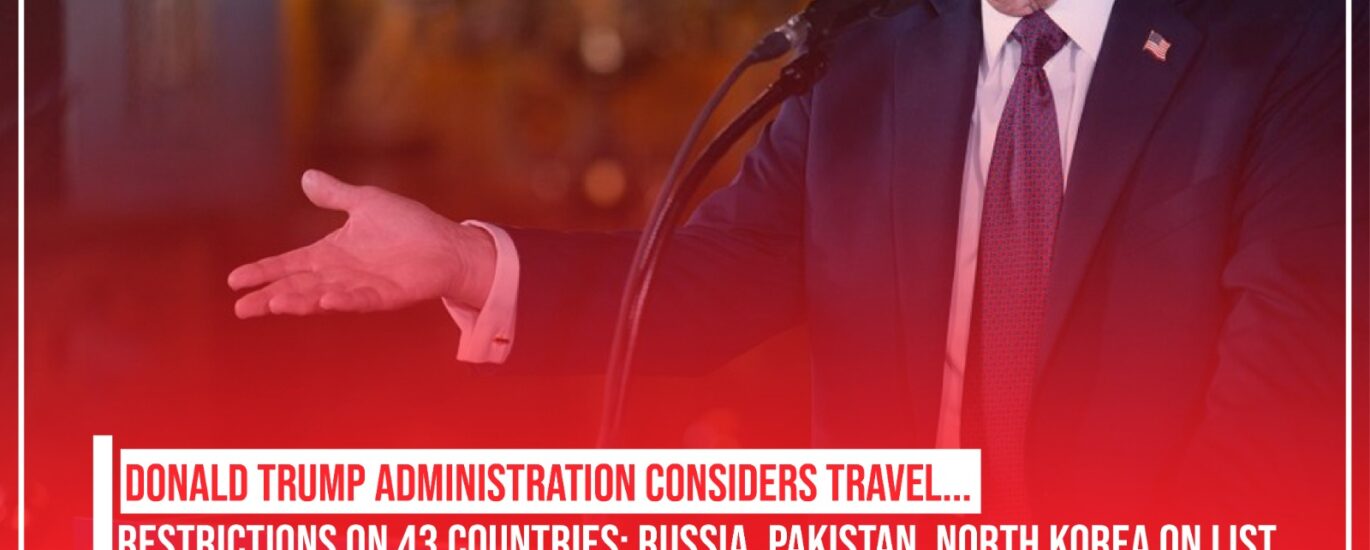In a bold move continuing his crackdown on immigration, the Donald Trump administration is reportedly weighing a significant shift in US immigration policies, including imposing travel restrictions on citizens from 43 countries. This measure, designed to address concerns over national security and inadequate vetting processes, has stirred debate and drawn significant attention.
The restrictions, which could dramatically impact millions of people across the globe, are part of President Trump’s broader efforts to tighten immigration procedures and curb illegal immigration. According to a report by The New York Times, the countries under consideration are divided into three distinct categories: “red list,” “orange list,” and “yellow list.” This classification system will determine the severity of the restrictions imposed on each country’s citizens, with some nations facing a full travel ban while others could face limited access.
Red List: Full Travel Ban for High-Risk Countries
The “red list” features the highest-risk nations, with 11 countries slated for a total travel ban to the United States. Citizens from these nations would be fully barred from entering the US under any circumstances. The countries that have been classified under this category include:
- Afghanistan
- Bhutan
- Cuba
- Iran
- Libya
- North Korea
- Somalia
- Sudan
- Syria
- Venezuela
- Yemen
This group consists of countries with known issues related to terrorism, political instability, or inadequate security vetting procedures. The Trump administration is particularly concerned that the citizens from these nations may pose a threat to national security, especially in light of the ongoing global challenges in terms of terrorism and extremist activities.
Orange List: Restricted Travel for Business Travelers
The second group, known as the “orange list,” comprises 10 countries where travel will still be allowed but under more stringent conditions. While citizens from these nations may be able to visit the US, restrictions will be placed on the types of visas they can obtain. Specifically, affluent business travelers may be granted access, but individuals seeking immigrant or tourist visas will be denied entry. The countries on the orange list include:
- Belarus
- Eritrea
- Haiti
- Laos
- Myanmar
- Pakistan
- Russia
- Sierra Leone
- South Sudan
- Turkmenistan
While citizens from these nations might still have some opportunities to travel to the US, their access will be limited and subject to a higher level of scrutiny. This decision is likely driven by concerns about inadequate vetting and the potential for individuals from these countries to overstay visas or pose security risks.
Yellow List: Monitoring for Compliance
The third category, known as the “yellow list,” contains the largest number of countries, totaling 22 nations. These countries will be given 60 days to address perceived deficiencies in their immigration vetting and security screening procedures. Failure to comply within this time frame could result in these nations being moved to the red or orange lists, with stricter restrictions on their citizens. The nations on the yellow list are:
- Angola
- Antigua and Barbuda
- Benin
- Burkina Faso
- Cambodia
- Cameroon
- Cape Verde
- Chad
- Republic of Congo
- Congo
- Dominica
- Equatorial Guinea
- Gambia
- Liberia
- Malawi
- Mali
- Mauritania
- St. Kitts and Nevis
- St. Lucia
- São Tomé and Príncipe
- Vanuatu
- Zimbabwe
These countries will be given a short grace period to improve their security processes. If they fail to meet the US’s criteria, they could face harsher restrictions similar to those in the red or orange lists.
Trump’s Crackdown on Immigration: A Continued Agenda
This proposed travel ban is part of a larger effort by the Trump administration to strengthen the United States’ immigration policies, which have been a cornerstone of his second term. Since his re-election in January, President Trump has taken a series of steps aimed at addressing what he perceives as flaws in the immigration vetting system.
Earlier this year, President Trump signed an executive order that mandated enhanced security screening for foreign nationals seeking entry into the US. The order tasked various government agencies with submitting a list of countries that should have travel restrictions imposed due to their inadequate vetting and security processes.
In addition to the proposed travel restrictions, the administration has ramped up its efforts to deport illegal immigrants, including those from countries such as India. There has been widespread criticism of the conditions under which deportees are sent back, with human rights advocates raising concerns over the practice of chaining and shackling deportees during their removal.
Also Read: What’s Mark Carney’s Immigration Agenda?
Global Impact and Criticism
The potential impact of these travel restrictions is vast, affecting millions of people worldwide. Citizens from the affected countries could face significant barriers to entry into the US, disrupting business, tourism, and family reunification. Additionally, some countries on the list, particularly those in the yellow category, will need to make significant improvements to their immigration systems in a short period.
Critics of the policy argue that it unfairly targets certain nations and could have adverse diplomatic consequences. Several countries have already voiced concerns over the proposal, and some have even threatened to take retaliatory measures if the ban goes into effect.
However, supporters of the measure argue that it is a necessary step to ensure the safety and security of the American people. By restricting entry from countries with inadequate vetting systems, the administration aims to mitigate the risks posed by potential security threats and ensure that only those who meet the highest standards of screening are allowed entry into the United States.
What’s Next for US Immigration Policy?
As the Trump administration moves forward with these proposed restrictions, the debate over US immigration policy continues to intensify. The travel ban, if approved, would be one of the most significant changes to immigration policy in recent years, and its impact will be felt by citizens of the affected countries for years to come.
Whether or not the policy will be implemented as planned remains to be seen. According to US officials, changes may still occur, and the list of affected countries is not yet final. Regardless of the final decision, the Trump administration’s stance on immigration is clear: national security remains a top priority.
For individuals and families in the affected countries, the potential changes to US immigration policy could significantly alter their plans for travel, business, or migration. It is advisable for those impacted to stay informed and consult with immigration experts, such as those at Mansory Immigration Consultants Pvt. Ltd., to navigate the evolving landscape of US immigration laws and travel restrictions effectively.
The Donald Trump administration’s proposed travel restrictions on citizens from 43 countries are part of a broader strategy to strengthen US immigration policies and address national security concerns. With the restrictions categorized into three distinct lists—red, orange, and yellow—countries will face varying levels of scrutiny, and those failing to meet the required standards may see their citizens banned from entering the US. As the situation develops, it is crucial for individuals affected by these policies to stay updated and seek professional guidance to ensure their compliance with the latest immigration rules.
Mansory Immigration Consultants Pvt. Ltd. offers expert advice and support for those navigating these complex changes. Whether you’re seeking to travel, work, or immigrate to the United States, our experienced consultants are here to help guide you through the process. Stay informed and prepared for the challenges ahead.





